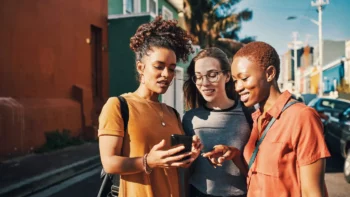
Creators, Creators, Creators: 3 Top Tips To Unlock Success with Gen Z
Article Highlights
- Creator Marketing at YMS New York
- 1. Creators might not be physical, anymore...
- 2. It's time to diversify your content
- 3. Anyone can be a content creator (yes, really)
Be the first to access new posts and exclusive content
Did you know that 75% of Gen Z follow content creators? Yep – it’s official: creators are your gateway path to capturing this demographic. Not only are creators a valuable way to facilitate trust, they also give brands a chance to build new connections.
If you’re a brand who’s looking to get involved with creator marketing, but doesn’t have the faintest clue on where to start: don’t worry. We’ve done *some* of the heavy lifting for you, and condensed three top takeaways. And these takeaways aren’t just general insights – they’ve been cherry-picked right from the mouths of the experts.
Creator Marketing at YMS New York
In March, Voxburner brought together industry experts and some of the hottest names shaping Gen Z culture today for our event, YMS.
YMS is the world’s largest youth marketing conference, tailored for anyone looking to understand, engage and target the Gen Z audience. Attended by marketers from all brands and headlined by industry trail-blazers, YMS is always an unforgettable experience.
This year, on the Creator Track, we had sessions from Twitch, PepsiCo, Paramount, Student Beans, Digital Voices, Archrival (to name a few!). Check out our three top takeaways.
P.S) If you missed out on New York, don’t worry – YMS London is right around the corner. Secure your pass today.
1. Creators might not be physical, anymore…
Yes, you read that right.
We recently wrote about the rise of virtual influencers. As we descend into a world more focused on technology than ever, the virtual creator is gaining traction. This was touched on in a session at YMS New York, where Andrew Dawson from Brandwatch shared that “robots are the future” for creator marketing.
Why is this?
Well, firstly virtual influencers can be crafted to look however the brand wants them to look. They can be customised to embody aspirational values and integrate with the brand’s image.
Secondly, they can be programmed to consistently deliver brand-specific messages, ensuring brand alignment and minimising the risk of unpredictable behaviour or controversies.
Finally, they’re not bound by time or physical locations – forget things like time off and bank holidays: the virtual creator is available at all times.
2. It’s time to diversify your content
Okay, so you’re taking it one step at a time, and working with a physical creator. Great!
Now, it’s time to remember that your audience is inundated with content. In fact, as shared by Jess Flack from Ubiquitious, 46% of consumers feel fatigued by creator content, whilst young people’s engagement has dropped to a paltry 12%. Thanks to social media, attention spans are shorter than ever before (sub 10 seconds, if you’re wondering. No pressure…).
Thankfully, creators can come in pretty handy here.
Creators bring a unique standpoint to the table, leveraging their story-telling abilities and creative talents. Brands can leverage the expertise and influence of these creators to co-create content that actually reflects the interests of their target audience. Take Corona, for example.
At a first read, we’re assuming your mind went straight into pandemic-fueled frenzy. In 2020, that’s exactly what Corona recognised, too.
After seeing their sales dip, Corona embarked on a creator-led campaign that promoted its sustainability initiative. Working with micro-creators, Corona released over 1,000 posts around this campaign – and it worked. Over 6.5 million people engaged with the posts. Since then, Corona has become the first beverage brand to achieve a net-zero plastic footprint; even constructing a sustainable beach bar back in 2021.

3. Anyone can be a content creator (yes, really)
As we know, authenticity isn’t just a buzzword for Gen Z: it’s a way of life.
It’s for this reason that Gen Z are drawn to smaller-time creators. As we shared in our Supercharge Your Gen Z Marketing guide, micro-creators have a 17.7% higher engagement rate, and this is all down to their perceived relatability.
Micro creators often don’t have the same high KPI’s that macro-influencers have, meaning they’re able to invest in more authentic content over forced monetisation. As Jess also shared “your next-door neighbour could be an influencer!”.
For brands, this is important because it democratises the creator marketing world. Bigger isn’t always better – so if you’re put off due to budget constraints or by the fact your brand isn’t globally recognised, it’s time to quell those concerns.
Want more top tips from us? Why not check out our full creator marketing guide, or subscribe to our weekly briefing, and have the latest insights, research, and Gen Z trends delivered to your inbox every week.



